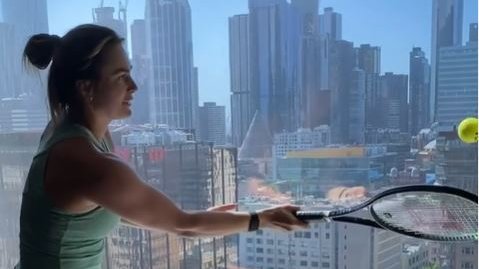Confined to their hotel rooms for two weeks and unable to train, some tennis players have come up with novel ways to prepare for the Australian Open.
Positive COVID-19 cases on three charter flights to Melbourne, from Los Angeles, Abu Dhabi and Doha, saw dozens of players named as close contacts, meaning they are unable to leave their rooms, even to train.
While the players say the two-week quarantine seriously curtails their ability to prepare for the grand slam, tournament organisers say they are providing equipment to the players so they can train.
But the players themselves are trying to make the most of a bad situation.
Mattress, windows and walls prove makeshift training surfaces
Kazakhstan’s Yulia Putintseva, Uruguay’s Pablo Cuevas and Switzerland’s Belinda Bencic all shared footage of themselves on social media training inside their rooms, hitting balls against varying surfaces.
Loading
Loading
Loading
Russia’s Anastasia Potapova and Belarus’s world number 10 Aryna Sabalenka were determined not to let their skills drop.
Loading
Loading…
British player Heather Watson shared an video of herself running in her room with the caption, ‘5k’.
Loading
Finding a way to kill time
But for some players, it’s not all about the game.
Former Australian Open winner Naomi Osaka, who is in Adelaide and is able to leave her room to train, said she would be spending her downtime playing with some shots of a different kind.
Loading…
Russians Daria Kasatkina and Anastasia Pavlyuchenkova put together a montage.
Loading
American player Tennys Sandgren, who was on the charter flight from Los Angeles and is unable to leave his room, is also filling his time by playing video games.
Loading
Complaints about close contact rules
There has been some confusion among players about the quarantine situation some players have found themselves in.
Some have claimed they were not told the entire planeload of passengers would need to self-isolate for two weeks if someone on board tested positive for COVID-19.
But Victorian authorities and the Australian Open said players were fully aware of the quarantine requirements before they arrived in Australia
“What I don’t understand is that, why no-one ever told us, if one person on board is positive the whole plane need to be isolated … I would think twice before coming here,” Putintseva said on Twitter.
Romanian player Sorona Cirstea said after isolating for two weeks, she would need “at least three weeks after in order to be in decent form again and compete at a high level”.
She also said she was not aware everyone on a flight would be considered a close contact if a passenger tested positive.
Loading
Loading
Bencic said after arriving in Melbourne, players received an information book with rules they did not know about before they decided to compete in the Australian Open.
“We are not complaining to be in quarantine. We are complaining because of unequal practice/playing conditions before quite important tournaments,” she said on Twitter.
But New Zealand player Artem Sitak, who was on the flight from Los Angeles, said everyone knew what they were getting themselves into.
“We had a call with Tennis Australia about a month ago and not a lot of players were on that call, which was surprising to me,” he said in a video posted on Twitter.
“Basically, the organisers told us the risks they were going to be undertaking and they did mention if someone tested positive on a flight, it’s going to be up to the health authorities to decide whether to quarantine all the flight or segments of the plane.
“In our case, where the flight attendant tested positive, of course the whole plane has to be quarantined.”
Belgian player Kirsten Flipkens called for the tournament to be pushed back a week so all players had the opportunity to train properly for the tournament.
Loading
The Australian Open is due to start on February 8.







